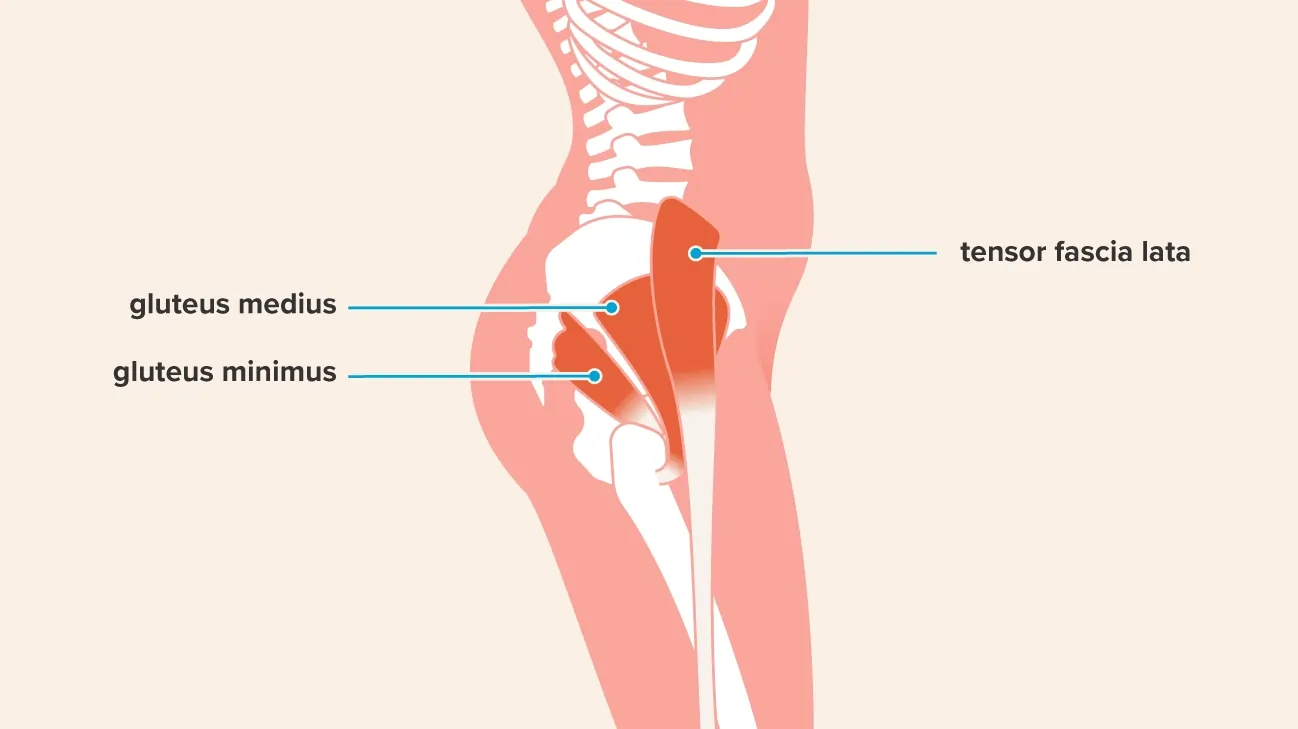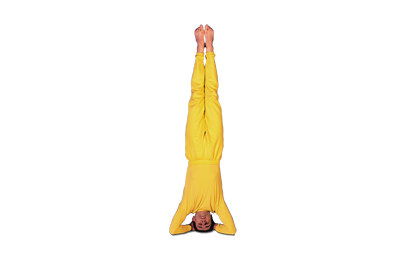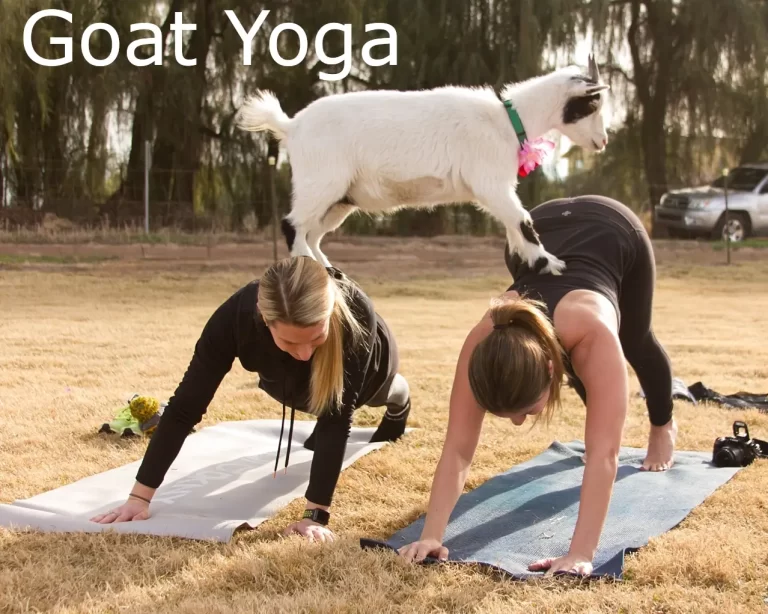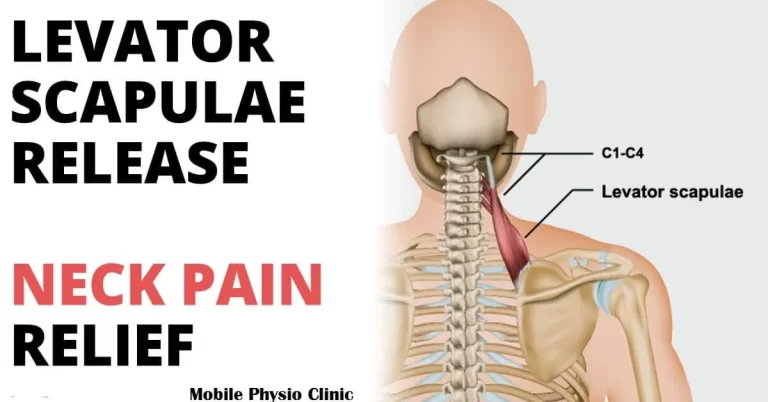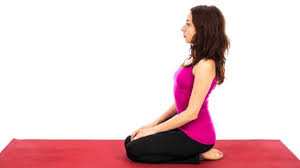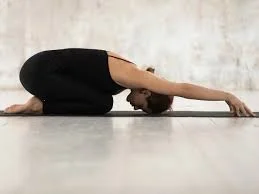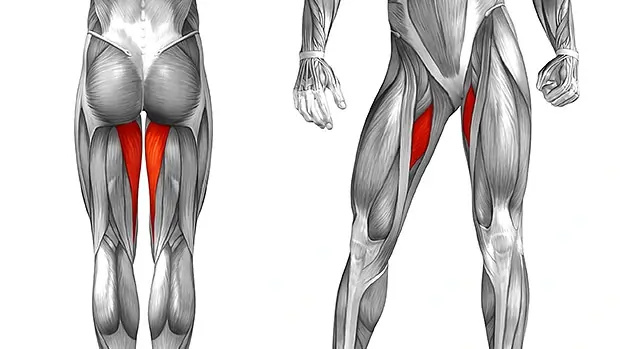Hip abductors exercise
Hip abductors exercise is the best way to make your muscle powerful and flexible that have many health benefits for people of all ages, especially sports person.
Table of Contents
Introduction
- Hip abduction exercise strengthens the hip abductor’s muscle. hip abductors exercise Prevent helps to prevent injury, Strong hip abductor muscles protect against injury. Without sufficient strength in the hip abductor muscle, our knees have the tendency to move inwards when we walk or run, leading to a “knock knee” position. It helps to reduce knee valgus It helps to Better muscle activation and performance. It also helps to Decrease pain.
- Hip abduction leads to any movement which can move your leg away from your body. The hip abductors muscle arises from the thigh bone to the pelvis, these muscles help us to support ourselves when we walk, stand, and engage in any physical activity. Strengthening these muscles helps us to make our daily activities more easily. Doing regularly this exercise helps you to prevent pain and injury of your hip.
- These three muscles are mostly involved to perform hip abduction movement: the gluteus medius, gluteus minimus, and tensor fasciae latae muscles.
- The gluteal muscles make up our buttocks. Our glutes have three different muscles: the gluteus maximus, gluteus medius, and gluteus minimus. The gluteus maximus gives you most of the shape, power, and explosiveness. The overshadowed gluteus medius and minimus are the prime movers for hip abduction movement. The tensor fasciae latae is a small muscle situated in your upper thigh that supports your body for a walk. While small in size, this hip abductor provides significant stability to your lower body.
- Hip Adductor muscle exercise includes two types of exercise
- Strengthening exercise
- Stretching exercise
Health Benefits Of Hip Abductor Exercises
- While strengthening the hip abductors muscle may not impress people at the gym, we can not afford to neglect these important muscles. Specifically training the hip abductors muscle is crucial for many reasons.
- Injury Prevention
- Strong hip abductor muscles protect against injury. Without sufficient strength in the hip abductor muscle, our knees have the tendency to move inwards when we walk or run, leading to a “knock knee” position.
- Knock knee or valgus position put stress on your knee joints and may easily cause strains in the muscles of the lower body.
- Strengthening of the hip abductor muscle can help you to avoid the above health issues and maintain proper lower body alignment, and move with safety and efficiency.
- Improved Agility
- As mentioned above, hip abductor muscles are responsible for moving our legs away from the body. If your hip muscles are weak then, it is extremely difficult to move your leg away from the body.
- On the other hand, strong hips allow you to quickly change position and move about with efficiency.
- It helps to Improve Strength Performance
- It helps to reduce knee valgus
- It helps to Better muscle activation and performance
- It helps to Decrease pain
- Weakness in your hip abductor muscle, particularly the gluteus medius, may lead to overuse injuries, patellofemoral pain syndrome (PFPS), and iliotibial (IT) band syndrome. patellofemoral pain syndrome can cause pain back to the kneecap when you sit for prolonged periods or when going downstairs.
Strengthening Exercises
Fire Hydrants
- How to do it?
- This is a simple bodyweight glute isolation exercise that mainly works on the gluteus medius.
- For the Fire Hydrants exercise, you have to take a quadruped position(on all four limbs). your leg should be bent, raise your right leg out to the side until reaches hip height.
- Squeeze your gluteus medius and return to the starting position.
- Again perform the same movement for 20 to 22 repetitions then move to the right side leg.
- Complete 2 to 3 sets of 20 to 25 repetitions on both side leg.
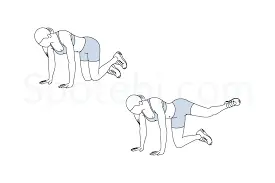
Hip Abduction with Cable
- How to do it?
- For the Hip Abduction with Cable exercise, you need a cable machine. this can be a powerful tool in developing hip abductor muscle.
- You have to Set up the cable machine at the lower pulley setting.
- Wrap the ankle slip to your outer foot and hold the machine for stability with the closed hand.
- Your both legs should be extended, and squeeze your hip abductor muscle to bring your outer leg straight out to the lateral side.
- Hold for 3 to 5 seconds at that point, and slowly return to the starting position.
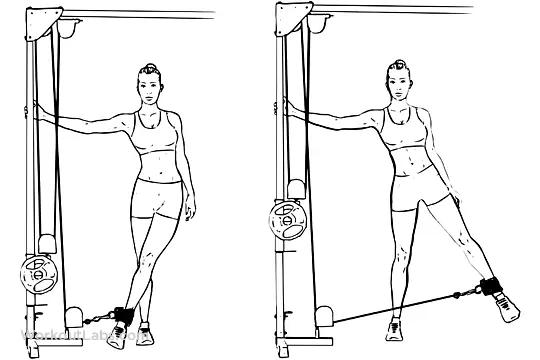
Leg Out Side Circles
- How to do it?
- The Leg Out Side Circles exercise may look simple, but you will feel the burn in your gluteus medius and minimus muscle during this exercise.
- For the Leg Out Side Circles exercise, you have to come in all four limbs with your hands directly under the shoulders.
- Straight the right leg out to the side with your toes pointing forward.
- Then Contract your glute muscle to move your foot in a circular direction.
- Make sure to switch the direction of the circle and switch to another leg.
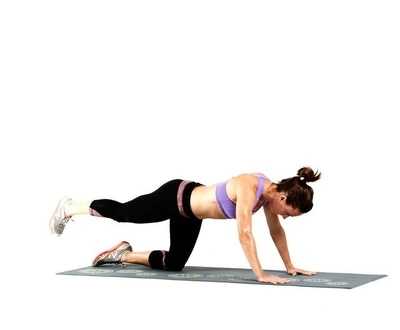
Side Lunge (Weight Optional)
- How to do it?
- This is a great lunge alternative that targets your hip abductor muscle. Take the standing position with your toes slightly flared out and your feet wider than shoulder-width apart.
- Keep your right leg straight, bend your left knee, and shift your weight to your left side.
- Then, transition to the starting position and repeat on the right side.
- Do this with alternate legs.
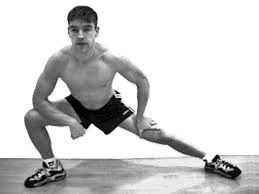
Leg Out Side Kickouts
- How to do it?
- The leg outside kickouts is a challenging exercise to test the stamina of your gluteus medius muscle.
- For the Leg Out Side Kickouts exercise, you have to take a quadruped position(on all four limbs). bend your knee, then kick outside and extend your leg.
- Switch the leg and do it again.
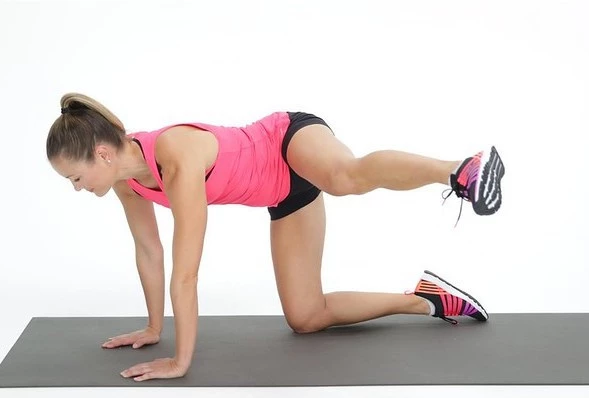
One-Legged Hip Thrust
- How to do it?
- This is a powerful body-weight glute and hip exercise.
- For the One-Legged Hip Thrust exercise, you have to lie on your back with your knee flexed, your arms should be by your side, and your palms facing downward. straighten your right leg and squeeze the glutes to thrusts the hip towards the ceiling.
- Pause at the top and slowly return to the starting position.do this on the left leg.
Lying Hip Abductions
- How to do it?
- The Lying Hip Abductions exercise will primarily target your gluteus medius and the gluteus minimus muscles.
- For the Lying Hip Abduction Exercise, you have to lie on your left side with your legs out straight and your upper body supported by the forearm.
- Squeeze the gluteus minimus muscle to elevate your right leg as high as possible by you.
- Hold for a couple of seconds then slowly return to the starting position.
- Do this movement on the other side of the leg.
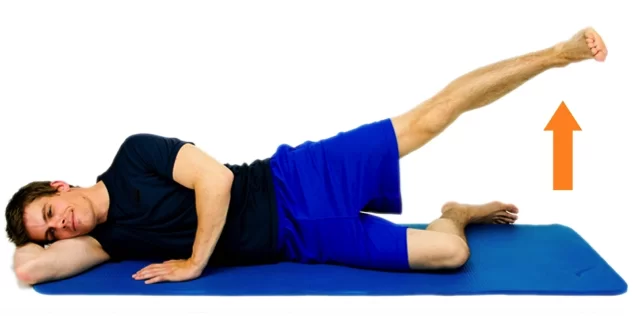
Curtsy Lunge
- How to do it?
- This is another lunge variation that intensely activates the gluteus medius muscle.
- For the Curtsy Lunge exercise, you have to stand with your back straight and chest held high. with your right foot straight in front of you, step with the left foot back and to the right.
- Both knees should be bent and your legs should be crossed. make sure your right knee is directly below the right ankle.
- Then drive up in a controlled motion to the stand position. Repeat this same movement to your left foot out in front.
- You may switch your legs after every repetition or after completing each set.
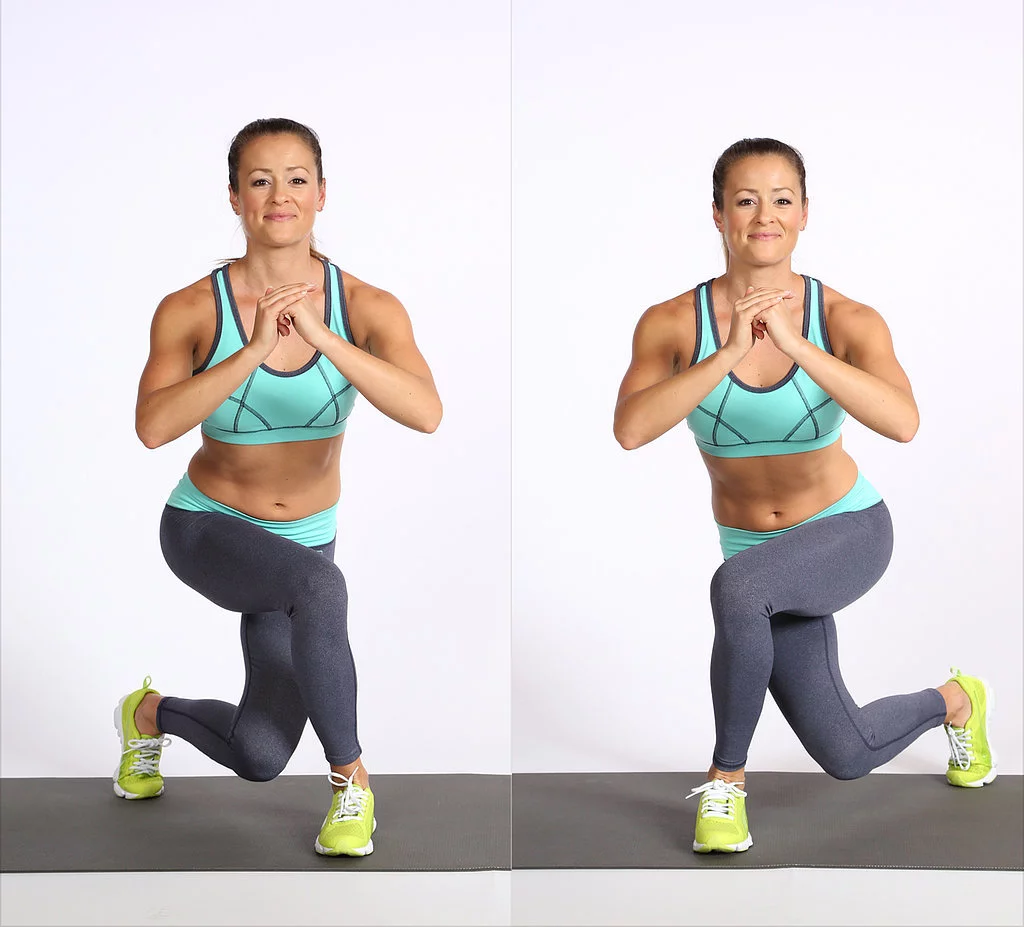
Leg Out Side Pulses
- How to do it?
- If you want to target the gluteus medius muscle, leg outside pulses are for you.
- For the Leg Out Side Pulses exercise you have to take a quadruped position(on all four limbs). extend your right leg straight out to the side with the toes facing forward. pulse the leg upward and downward for 10 to 15 repetitions of 1 to 2 sets.
- Then move to the left leg.
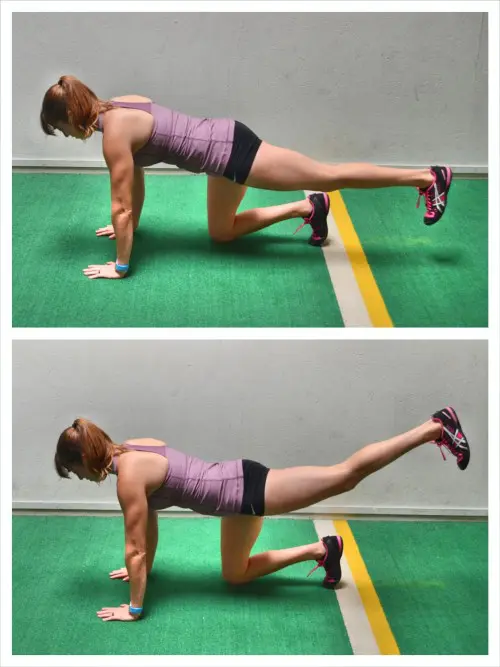
Step Up with Leg Raise
- How to do it?
- This exercise becomes a great source of activation for your hip adductor muscles. This step-up action also adds a small number of cardiopulmonary workouts to your routine.
- For the Step Up with Leg Raise exercise, you need a bench or a small platform that is at least 2 to 3 feet off the floor.
- However high you are comfortable stepping is fine, just make sure it is at least a little more challenging.
- Step up with your left leg and then raise the body by driving through the left ankle. Put your right foot on the platform and then pull the right leg back.
- This will directly activate the adductor muscles on your inner thigh.
- If you have not worked them out before, you can be quite sore after a few repetitions of these step-ups.
- Bring the right leg back in, then go back down to the starting position and repeat the action with the right foot leading.
- Repeat the same number of repetitions on both side leg.
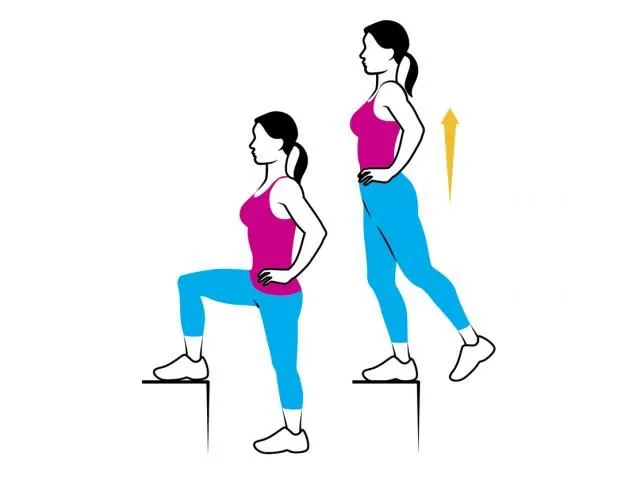
Clamshell
- How to do it?
- The Clamshell exercise may look a little silly but is a great and easiest way to strengthen the hips. It also can be a useful tool in detecting imbalances in the hips.
- For the Clamshell exercise, you have to lie on your left side and take forearm support to your head like a pillow.
- Stack your knees and hips flexed together up to 45 degrees. your body should be in a neutral position and your head, neck, pelvis, and feet are in the same alignment.
- Your feet should be stacked and your core muscles engage and rotate your right knee upward and open by using your hip.
- Hold this position for 4 to 5 seconds and then return to the starting position.
- Do this movement 10 to 15 times on both side legs.
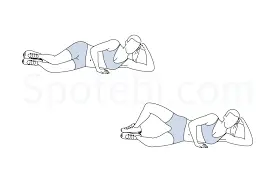
Resistance Band Side Walks
- How to do it?
- This is a very effective way to strengthen your hip muscles. you can start with body weight lateral steps.
- Wrap the resistance band just above the ankle joint.
- Stand with your feet under your hips and squat down into the semi-seated position. your shoulders should be back and down and your gaze should be forward.
- Take a Step out to the side, pushing with your heel against the resistance band.
- Then Step together again so your feet are once again hip-feet width apart.
- Focus on using the hips to drive the foot out and be sure to watch that the feet should be parallel. Your toe will tend to try to lead the movement. You have to Keep tension on the resistance band at all times.
- Continue stepping to the side for 8 to 12 steps.
- Return in the other direction for 8 to 12 steps.
- If you have limited space, you can do these in a stable position. Just be aware to press your body out with the foot and not let your foot do all the in and out motion by itself.
- Advanced: start with light resistance and work up to more resistance bands to increase strength.
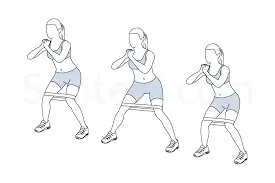
Hip Drop
- How to do it?
- This exercise is mainly used to rehabilitate a weak hip abductor muscle, which can lead to mechanical issues in the legs, such as iliotibial band syndrome.
- This simple, yet intentional, move needs to be done with control and body awareness to ensure that your hip is initiating the movement rather than the legs.
- For the Hip Drop exercise, you have to stand on a step-raised surface with one foot. you should stand straight. lower down your opposite leg, and start the movement from your hip joint.
- Your shoulder should be stable during the entire movement. You have to Hold the lower down position for 2 to 4 seconds without letting your pelvis rotate. return to neutral hip position.
- Make both legs lower and lift slowly in the controlled movement.
- Complete 12 to 20 repetitions on both side leg.
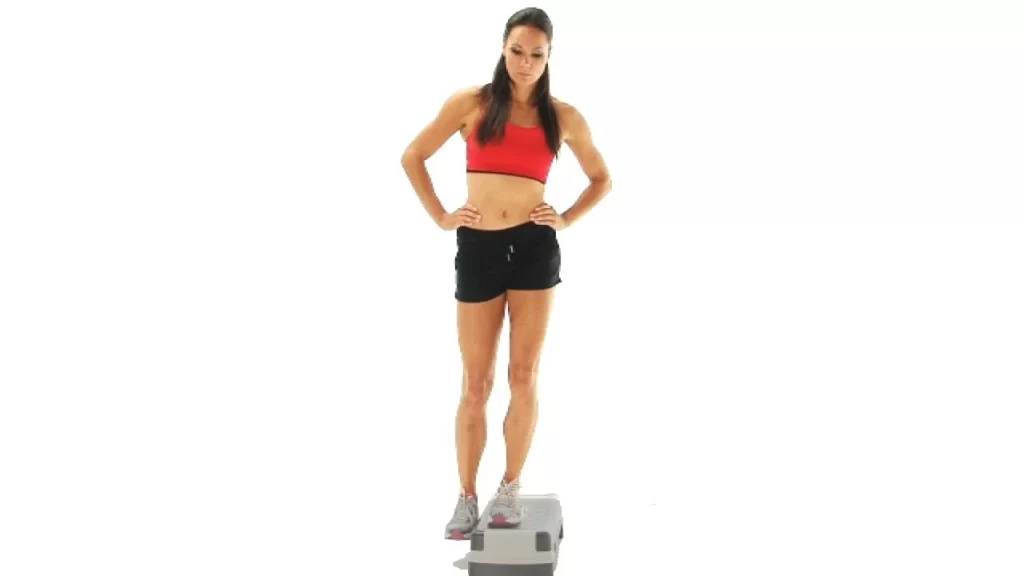
Sitting hip abduction with resistance band
- How to do it?
- For the Sitting hip abduction with resistance band exercise, you have to sit in a chair. wrap the resistance band around your knees or above the knees, with your knees hip shoulder-width apart.
- Smoothly move your knees outside against the resistance band and then bring them close to your body.
- Maintain an upright posture throughout this exercise.
- You can do 10 to 15 repetitions of 2 to 3 sets.
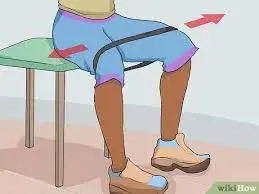
Side plank hip abduction
- How to do it?
- Lie on your right side and place your forearm under you to support the body weight.
- Place your left hand on your hips. Then, place your left fist on your stomach to the hips for balance.
- Then raise your trunk and hips until your body is in a straight line and then raise your left leg in the air.
- Exhale during this part of the exercise. Hold for 2 to 5 seconds.
- Then, lower your left leg until it is on top of your right, and lower your hips back down until your buttocks make contact with the floor.
- Breathe during this portion of the exercise.
- Complete your desired number of repetitions.
- Then, switch to your left side and do the same for the 15 to 20 repetitions.
- Do this on Alternate legs for 15 to 20 repetitions of 2 to 3 sets.
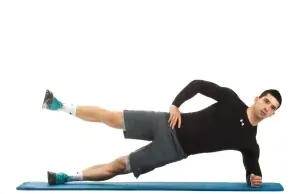
Stretching exercise
Seated figure-four stretch
- To do this stretch:
- the patient is in a sitting position in a stable chair.
- Put your right ankle on the left thigh, just above your knee.
- Put your hands on the shins.
- Keeping your spine upright, slightly bend forward to feel the deep stretch.
- Hold for 20 seconds.
- Return to the beginning position.
- Repeat with the opposite leg.
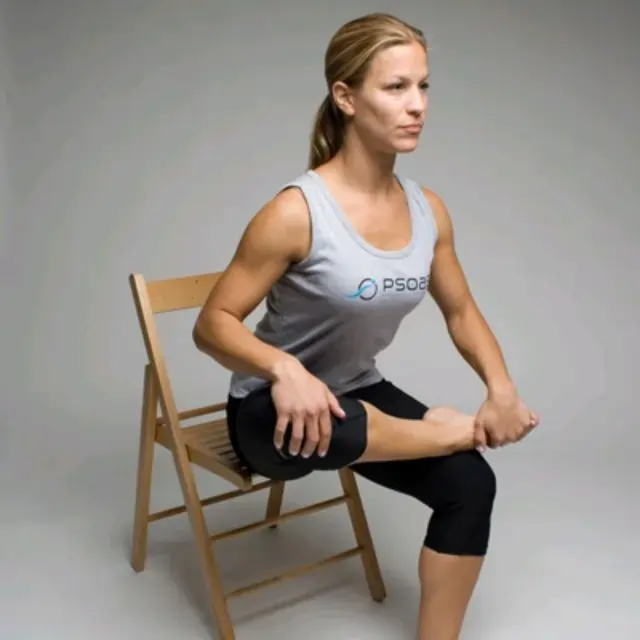
Standing figure-four stretch
- To do this stretch:
- The patient’s position is in standing and keep your spine neutral.
- Cross your left side ankle over the right thigh, just above your knee, to make a “4” figure.
- Hold on to a table for support.
- Gently bend your right knee, moving the hips down into the squat position.
- Pause when you feel the stretch in your left side glute.
- Hold for 15 to 20 seconds.
- Return to the starting position.
- Repeat with your opposite leg.
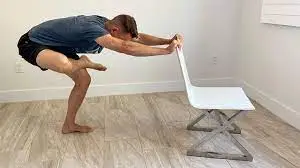
Supine gluteal stretch
- How to do it:
- Starting with lying flat on your back on the mat.
- Bend your both knees and place your feet firmly on the mat, assuring that they are hip-width apart and the spine is in the neutral position.
- Release and turn out your right leg so that your ankle is resting on the left leg, just above the knee.
- Move your left knee towards your upper body, resting both hands on the back of the left thigh.
- Hold this position for 15 to 30 seconds, breathing deeply continuously.
- Each time that you breathe out, draw your knee further into your chest and press your right elbow into the right knee to increase the stretch, assuring that the spine remains in the neutral position and your tailbone is on the floor.
- Repeat this stretch on the opposite side also.
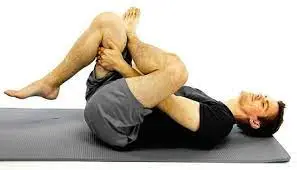
Seated gluteal stretch
- How to do it:
- The patient’s position is sitting in a chair. the spine is straight.
- Place your right foot on your left knee just above your knee.
- Now grab your right knee by your hand and draw towards the chest.
- Hold when you feel stretched.
- hold for 5 to 20 seconds then relax
- and repeat another side.

Downward-Facing Dog
- To do this stretch:
- Start with the push-up position, with your hands shoulder-width apart and legs together.
- Upright your body and engage the core.
- Draw your hips back and up, forming an upside-down “V” by your body.
- Gently bend your knees and put the head between the shoulders, keeping it in line with the spine.
- Reach your heels toward the floor but keep them lifted slightly.
- Hold for 15 seconds. Return to the starting position.
![Downward Facing Dog Pose[Adho Mukha Svanasana]](https://mobilephysiotherapyclinic.net/wp-content/uploads/2023/12/Downward-Facing-Dog-PoseAdho-Mukha-Svanasana.webp)
Pigeon Pose
- To do this stretch:
- Begin on all fours. Then Move your right knee toward your right wrist, placing your shin on the floor.
- Move your right ankle toward the left wrist.
- Slide back your left leg, point your toes, and keep your hips facing forward. Extend the spine.
- Slowly walk the hands forward. Hold for 5 to 10 seconds.
- Return to the starting position. Switch your legs and then repeat.
Reclined Pigeon
- To do this stretch:
- start by lying on the floor.
- Then Bend your legs and the soles of your feet flat on the floor.
- Raise your left leg to bring your left ankle to rest on your right thigh, just above the knee.
- Flex your left foot and wrap your arms around your right thigh, slowly pulling it closer to your chest as you press your left knee away from the body.
- Hold for 30 to 60 seconds before repeating on the opposite side of the leg.
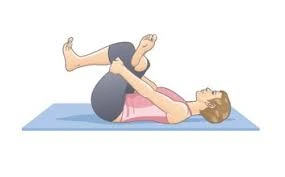
Modified Pigeon
- To do this stretch:
- Sit on the floor with your legs straight out in front of you and hands-on on either side of your hips. Then, flex your right foot, bend your right knee, and bring your shin towards your body, maintaining it as perpendicular to the thigh as you can.
- Simultaneously swing your left leg behind you and slowly bend it.
- Slowly press into the tips of the fingers for balance.
- Hold for 30 to 60 seconds before repeating the motion on the opposite side of the leg.
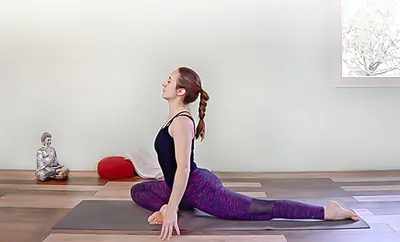
Recline Knee To Chest
- To do this stretch:
- Start by lying on the back with the legs straight.
- Then Bend your left knee and wrap your arms around the shin.
- Gently pull the knee by your hands towards the chest.
- Hold for 60 to 120 seconds, then repeat the motion on the opposite side.
- Repeat 2 times.
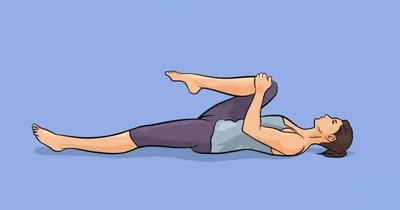
Knee to the opposite shoulder
- To do this stretch:
- Start by taking a supine lying position on the mat and straightening your legs in front of you.
- Bend and lift your right knee and put your hands around the right knee.
- Pull your right knee up toward your left shoulder.
- Hold for 15 to 30 seconds.
- then return your right leg to the starting position.
- Straighten your right leg and repeat with your other leg also.
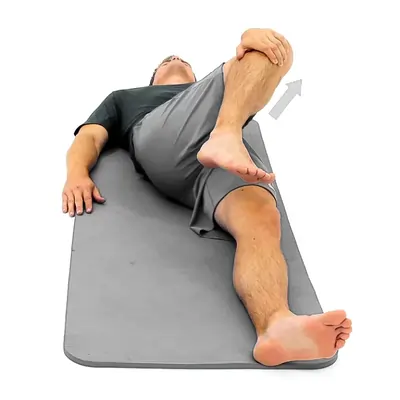
Seated twist
- To do this stretch:
- Sit on the ground and stretch your legs forward.
- Place your left arm behind you and bring your left leg over the right one.
- Place your left foot on the ground near the right knee.
- Position your right arm over the left knee, with the palm facing outward.
- Twist to the right and use your right arm to pull the left knee inward.
- Hold for 15 to 30 seconds.
- Untwist and repeat on the opposite side of the leg also.
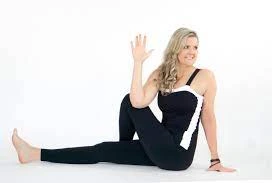
Standing side bend
- To do this stretch:
- This stretching exercise will also stretch your upper body.
- Use the wall for support and balance, and take the standing position with one side of the body towards the wall.
- Then cross your leg afar from the wall in front of your opposite side of the leg.
- Now Place your one palm on the wall and the other palm on the hip.
- Then you have to bend your body away from the wall and push the hip toward the wall.
- Hold for 15 to 20 seconds before repeating on the opposite side also.
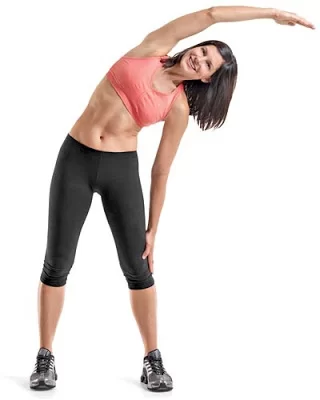
Glute bridge
- To do this stretch:
- Take the lying position on your back with your knees bent and your feet flat on the floor.
- Put your feet hip-width distance apart and gently contract your core muscles.
- Slowly breathe out while maintaining your core contracted and then raise your hips up and from the floor.
- Slowly contract your glute muscle and do not raise your hips past the point of comfort.
- Hold for 10 to 15 seconds, inhale, and gently lower yourself back to the beginning position.
- Repeat 5 to 8 times.
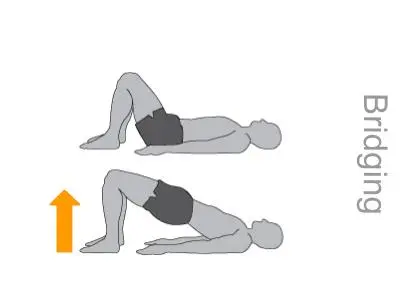
Glute bridge with band
- To do this stretch:
- Tie up the small, tight resistance band around your calve muscle.
- Take the supine position on your back and raise your hips up.
- Maintain tension in the resistance band and tap the hips down on the floor before lifting them back up again.
- It is very important to keep your spine straight and make the motion come from the hips.
- Repeat 10 to 15 times.
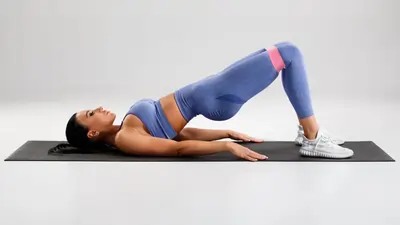
Seated hip abduction with resistance band
- To do this stretch:
- Sit on the floor and tie up the resistance band around your calve muscle.
- bend your knees and maintain your feet on the floor.
- Put the hands behind you slightly.
- Keep the back straight and press the legs out to the sides as you rotate the hip laterally.
- Gently, and with control, bring the legs back together. Holding time should be 10 to 15 seconds.
- Repeat 8 to 10 times.

Lizard Pose Variation
- To do this stretch:
- Start in the high plank position with your hands directly under the shoulders.
- Bend your right knee to bring your right foot outside of the right hand, assuring your right knee is in line with your right ankle.
- Rest your left knee on the floor.
- Then Press your right foot into the floor and gently push your right knee outward.
- To feel a deep stretch, lower the forearms to the floor.
- Hold for 60 to 120 seconds before repeating the motion on the opposite side.
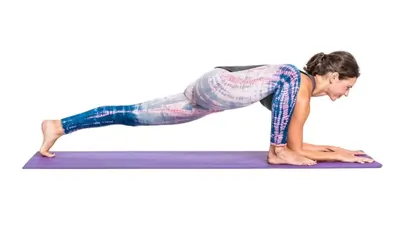
Cow-Face Pose (Recline)
- To do this stretch:
- Start by lying on your back and your legs bent.
- The soles of the feet are flat on the ground. Cross your right thigh over your left side thigh.
- Maintaining your head on the mat, use your hands to slowly pull your shins up toward the chest.
- Bring your shins perpendicular to your upper body as possible for you.
- Hold for 60 to 120 seconds before repeating the motion with your left thigh over the right.
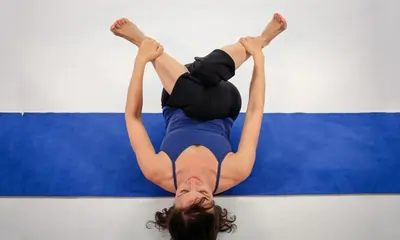
Standing Straddle
- To do this stretch:
- Start with your feet 2 to 3 feet apart with the toes angled inward slightly.
- Bend forward at waist level and walk your hands to the right ankle.
- Hold for 30 to 60 seconds before walking your hands to the left ankle.
- Repeat 3 to 4 times.
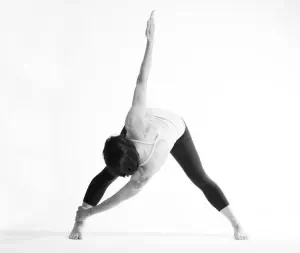
Rotated Low Lunge
- To do this stretch:
- Start in the high plank position with your hands directly under the shoulders.
- Bend your left knee to bring the left foot outside of the left hand, assuring your left knee is in line with the left ankle.
- Lift your left arm toward the roof, rotating your chest towards the left knee.
- Look over your left shoulder toward the roof.
- So your body forms a straight line from your head to the right heel.
- Hold for 60 to 120 before repeating the motion on the other side also.
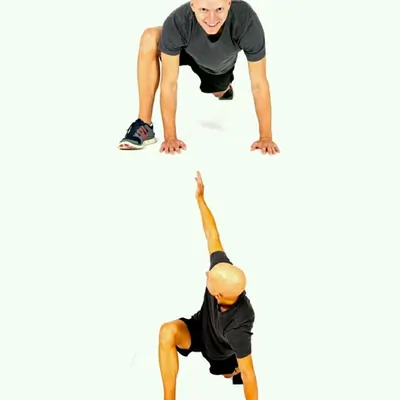
Kneeling Lunge Stretch
- To do this stretch:
- Lower into the kneeling lunge with your right knee on the floor and your left foot planted in front of you.
- Put your hands on your hips and gently push your left hip towards the left foot.
- Hold the position for 20 to 30 seconds, change sides, and then repeat.
Yogi Squat Pose
- To do this stretch:
- The position is standing with the feet wider than hip-width apart, toes facing either forward or slightly outwards.
- Bend your knees and squat down as much as possible you so that the hips come below the knees.
- Then Try to maintain your back as straight and upright as possible, pressing the hands together and elbows against the insides of your knees for assistance.
- Hold for 10 to 15 seconds and repeat.
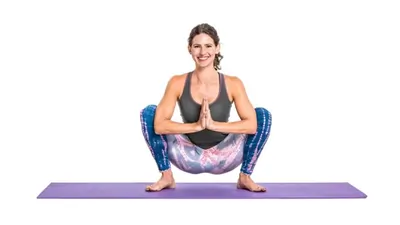
Child’s Pose
- To do this stretch:
- Start on your hands and knees, with your knees placed out wider than your hips.
- Then Sit back on the heels so the stomach lowers between your thighs.
- Slowly bend forward as possible.
- Keep your upper body straight as you continue to press your hips back and your arms forward.
- If comfortable, put your forehead on the floor.
- Hold the position for around 20 to 30 seconds and then repeat.

What are the common mistakes made during stretching?
- There are certain mistakes you should not make during stretch:
- Not Warming Up Before Stretching
- Stretching after warm-up motions reduces the risk of injury by giving unexpected flexibility to your muscle. Never perform stretching without the prior warm-up period unless you feel pain in your muscles.
- Not Stretching At All
- Always perform stretching before any exercise workout which helps your muscles to activate and take the load into them. Without any muscle stretching, you put your muscles in danger or it may tear your muscles because of the sudden weight loading into them.
- Not Stretching For Enough Time
- You have to stretch the muscles for enough time, every stretch requires a different amount of time. Static stretching should be around 30 – seconds, dynamic stretching is required 10 to 12 repetitions.
- Forgetting to Breathe
- Do not forget to breathe during the stretch, because you need more oxygen during the stretch. So make sure you continue your breathing while performing the stretch.
- Stretching Into An Injury
- If you are injured, you have to avoid stretching exercises through that injury pain. Stretching makes your muscles suffer and causes lots of pain, so make sure to not stretch any injured part.
- Stretching Until It Hurts
- Do not stretch your muscles until you feel pain. Stretching should be in a mild painful manner that is a little forced at the end of the stretching. So much pain during the stretch makes your muscles injured and damaged. Overstretching is dangerous for you.
When do not do these exercises?
- When your physician advised you to rest.
- When your leg bone is recently fractured.
- When you have recently undergone any leg or abdominal surgery.
- When you feel pain or any discomfort during this exercise.
Hip abductor machine
This hip abductor machine consists of two pads that rest on your outer thighs as you sit in the hip abductor machine. During using the machine, you push your legs against the pads with resistance provided by the weights. Not only can hip abduction exercises help you get a tight and toned backside, but they can also help to prevent and treat pain in your hips and knees.
Hip abductor exercises gym
For the Hip Abduction with Cable exercise, you need a cable machine. this can be a powerful tool in developing hip abductor muscle.
You have to Set up the cable machine at the lower pulley setting.
Wrap the ankle slip to your outer foot and hold the machine for stability with the closed hand.
Your both legs should be extended, and squeeze your hip abductor muscle to bring your outer leg straight out to the lateral side.
Hold for 3 to 5 seconds at that point, and slowly return to the starting position.
Hip abductor exercises for the elderly
The Lying Hip Abductions exercise will primarily target your gluteus medius and the gluteus minimus muscles.
For the Lying Hip Abduction Exercise, you have to lie on your left side with your legs out straight and your upper body supported by the forearm.
Squeeze the gluteus minimus muscle to elevate your right leg as high as possible you.
Hold for a couple of seconds then slowly return to the starting position.
Do this movement on the other side of the leg.
For the Sitting hip abduction with resistance band exercise, you have to sit in a chair. wrap the resistance band around your knees or above the knees, with your knees hip shoulder-width apart.
Smoothly move your knees outside against the resistance band and then bring them close to your body.
Maintain an upright posture throughout this exercise.
You can do 10 to 15 repetitions of 2 to 3 sets.
At-home hip abductor exercises
Lying Hip Abduction Exercise, you have to lie on your left side with your legs out straight and your upper body supported by the forearm.
Squeeze the gluteus minimus muscle to elevate your right leg as high as possible by you.
Hold for a couple of seconds then slowly return to the starting position.
Do this movement on the other side of the leg.
In the Fire Hydrants exercise, you have to take a quadruped position(on all four limbs). your leg should be bent, raise your right leg out to the side until reaches hip height.
Squeeze your gluteus medius and return to the starting position.
Again perform the same movement for 20 to 22 repetitions then move to the right side leg.
Complete 2 to 3 sets of 20 to 25 repetitions on both side leg.
Abductor exercises with dumbbells
Grasping the dumbbell with the hand of the arm furthest from the floor, position the dumbbell as low as possible on the top side of the thigh. Raise the weighted leg up off ground as high as possible, keeping the dumbbell positioned on side of the upper thigh. Return the leg to the floor and then repeat. Repeat and continue with the opposite leg.
FAQ
Fire Hydrants: This is a simple bodyweight glute isolation exercise that mainly works on the gluteus medius. For the Fire Hydrants exercise, you have to take a quadruped position(on all four limbs). your leg should be bent, raise your right leg out to the side until reaches hip height. Squeeze your gluteus medius and return to the starting position. Again perform the same movement for 20 to 22 repetitions then move to the right side leg. Complete 2 to 3 sets of 20 to 25 repetitions on both side leg.
Lying Hip Abductions: The Lying Hip Abductions exercise will primarily target your gluteus medius and the gluteus minimus muscles. For the Lying Hip Abduction Exercise, you have to lie on your left side with your legs out straight and your upper body supported by the forearm. Squeeze the gluteus minimus muscle to elevate your right leg as high as possible by you. Hold for a couple of seconds then slowly return to the starting position. Do this movement on the other side of the leg.
Hip abductor exercises work in the frontal plane of movement. That’s the side-to-side movement you get when you raise your leg to the side of the body, or when you step out to the side, like with a lateral lunge. The Lying Hip Abductions exercise will primarily target your gluteus medius and the gluteus minimus muscles. For the Lying Hip Abduction Exercise, you have to lie on your left side with your legs out straight and your upper body supported by the forearm. Squeeze the gluteus minimus muscle to elevate your right leg as high as possible by you. Hold for a couple of seconds then slowly return to the starting position. Do this movement on the other side of the leg.
Hip abductor muscle weakness contributes to problems like shin splints and foot hyper pronation (flat feet). Foot hyperpronation and hip abductor weakness are known, biomechanical coconspirators. Gluteus medius weakness increased pressure on the inside of the foot, reducing the typical arch of the foot.
Fire Hydrants: This is a simple bodyweight glute isolation exercise that mainly works on the gluteus medius. For the Fire Hydrants exercise, you have to take a quadruped position(on all four limbs). your leg should be bent, raise your right leg out to the side until reaches hip height. Squeeze your gluteus medius and return to the starting position. Again perform the same movement for 20 to 22 repetitions then move to the right side leg. Complete 2 to 3 sets of 20 to 25 repetitions on both side leg.
Hip Abduction with Cable: For the Hip Abduction with Cable exercise, you need a cable machine. this can be a powerful tool in developing hip abductor muscle. You have to Set up the cable machine at the lower pulley setting. Wrap the ankle slip to your outer foot and hold the machine for stability with the closed hand. Your both legs should be extended, and squeeze your hip abductor muscle to bring your outer leg straight out to the lateral side. Hold for 3 to 5 seconds at that point, and slowly return to the starting position.
Fire Hydrants, Hip Abduction with Cable, Leg Out Side Circles, Side Lunge (Weight Optional), Leg Out Side Kickouts, One-Legged Hip Thrust, Lying Hip Abductions
Curtsy Lunge, Leg Out Side Pulses, Step Up with Leg Raise, Clamshell, Resistance Band Side Walks, Hip Drop, Sitting hip abduction with the resistance band, and Side plank hip abduction exercises you can do to target your abductor’s muscles

